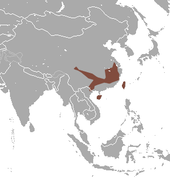Chinese island mole
| Chinese island mole | ||||||||||||
|---|---|---|---|---|---|---|---|---|---|---|---|---|
| Systematics | ||||||||||||
|
||||||||||||
| Scientific name | ||||||||||||
| Mogera insularis | ||||||||||||
| Swinhoe , 1863 |
The Chinese island mole ( Mogera insularis ) is a species of mammal from the genus of the East Asian moles within the moles (Talpidae). It is distributed over large parts of southern China as well as on the islands of Hainan and Taiwan .
features
The Chinese island mole is a small type of mole with a head-trunk length of 11.2 to 13.7 centimeters and a very short tail length of 0.7 to 1.4 centimeters. The weight is 42 to 72.5 g. The second species of mole, Mogera kanoana , found in Taiwan , does not quite reach these proportions, while the southern Chinese La Touche mole ( Mogera latouchei ) is becoming even smaller. The fur is slate gray to black on both the back and the stomach with the exception of a few white hairs on the feet and on the tip of the tail.
| 3 | · | 1 | · | 4th | · | 3 | = 42 |
| 3 | · | 0 | · | 4th | · | 3 |
The Chinese island mole differs from the long-nosed mole ( Euroscaptor longirostris ), which also occurs in southern China , primarily in its shorter and wider snout. In addition, the enlarged claws of the forelegs of the Chinese island mole are narrower and the number of teeth is smaller, since the species of the genus Mogera do not have lower canine teeth.
distribution
The distribution area of the Chinese island mole includes large parts of the south of the People's Republic of China as well as the islands of Hainan and Taiwan . The species was detected in the provinces of Guangxi , Hunan , Fujian , Zhejiang , Sichuan , Anhui , Guizhou , Jiangsu , Guangdong and Jiangxi . Some of the animals in the north of Vietnam were also considered to belong to the Chinese island mole, but according to genetic studies they are now assigned to their own species.
Mogera insularis is the only type of mole on Hainan, and Mogera kanoana is also found on Taiwan .
Way of life
Very little data is available on the way of life of the Chinese island mole. The species occurs both in the mountains in southern China and in the high mountain regions. Like all moles, it lives underground and digs tunnels in the ground where it feeds on insects and worms.
Systematics
The Chinese island mole is classified as an independent species within the East Asian moles (genus Mogera ). Historically it was assigned to the species Euroscaptor micrura , which today belongs to the Southeast Asian moles .
|
Internal systematics of the East Asian moles according to Shinohara et al. 2014
|
Within the species, in addition to the nominate form Mogera insularis insularis on Taiwan, the two subspecies Mogera insularis hainana on Hainan and Mogera insularis latouchei in southeastern China and Vietnam are differentiated. The distribution area of the form on Hainan is now separated from the nominate form, but the island was part of the mainland during the last Ice Age. The Vietnamese form has a highly fragmented habitat. The status of the two subspecies is unclear, mainly due to the sometimes clear morphometric differences to the nominate form, and it is assumed that they are separate species. This could also be proven genetically at least for the animals of southeast China and Vietnam, so that they have been listed as an independent species Mogera latouchei since 2014 . Furthermore, in 2007 the Kano mole ( Mogera kanoana ) on Taiwan was split off from the Chinese island mole and first described due to molecular genetic findings. The animals inhabit altitudes around 2800 m.
Hazard and protection
The species is classified by the International Union for Conservation of Nature and Natural Resources (IUCN) as not endangered ("least concern") due to its large distribution area and the assumed high population numbers. There are no known threats to the stocks.
supporting documents
- ↑ a b c Shin-ichiro Kawada, Akio Shinohara, Shuji Kobayashi, Masashi Harada, Sen-ichi Oda and Liang-Kong Lin: Revision of the mole genus Mogera (Mammalia: Lipotyphla: Talpidae) from Taiwan. Systematics and Biodiversity 5 (2), 2007, pp. 223-240.
- ↑ a b c d e f Insular Mole. In: Andrew T. Smith , Yan Xie (Eds.): A Guide to the Mammals of China. Princeton University Press, Princeton NJ et al. 2008, ISBN 978-0-691-09984-2 , p. 324.
- ↑ a b Mogera insularis in the IUCN Red List of Threatened Species 2012.2. Listed by: Andrew T. Smith , CH Johnston, 2008. Retrieved April 14, 2013 ..
- ↑ a b c Akio Shinohara, Shin-Ichiro Kawada, Nguyen Truong Son, Chihiro Koshimoto, Hideki Endo, Dang Ngoc Can and Hitoshi Suzuki: Molecular phylogeny of East and Southeast Asian fossorial moles (Lipotyphla, Talpidae). Journal of Mammalogy 95 (3), 2014, pp. 455-466.
- ↑ a b c Mogera insularis . In: Don E. Wilson , DeeAnn M. Reeder (Eds.): Mammal Species of the World. A taxonomic and geographic Reference. 2 volumes. 3. Edition. Johns Hopkins University Press, Baltimore MD 2005, ISBN 0-8018-8221-4 .
literature
- Insular mole. In: In: Andrew T. Smith , Yan Xie (Eds.): A Guide to the Mammals of China. Princeton University Press, Princeton NJ et al. 2008, ISBN 978-0-691-09984-2 , p. 324.
Web links
- Mogera insularis inthe IUCN 2012 Red List of Threatened Species . 2. Listed by: Andrew T. Smith , CH Johnston, 2008. Retrieved April 14, 2013.
